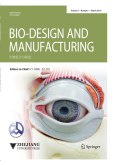- 钛学术文献服务平台 \
- 学术期刊 \
- 基础科学期刊 \
- 生物科学期刊 \
- 生物设计与制造(英文版)期刊 \
Preparation of conductive and transparent dipeptide hydrogels for wearable biosensor
Preparation of conductive and transparent dipeptide hydrogels for wearable biosensor
基本信息来源于合作网站,原文需代理用户跳转至来源网站获取
摘要:
Conductive and transparent dipeptide hydrogels are desirable building blocks to prepare soft electronic devices and wearable biosensors due to their excellent biocompatibility,multi-functionality,and physiochemical properties similar to those of body tissues.However,the preparation of such hydrogels featuring high conductivity and transparency is a huge challenge because of the hydrophobic feature of conductive additives making the doping process difficult.To overcome this issue,hydrophilic conductive polydopamine (PDA)-doped polypyrrole (PPy) nanoparticles are introduced into the dipeptide hydrogel networks to form conductive nanofibrils in situ to achieve a good level of hydrophilic templating of the hydrogel networks.This tech-nique creates a complete conductive network and allows visible light to pass through.The strategy proposed herein not only endows the dipeptide hydrogel with good conductivity and high transparency,but also provides a great potential application of conductive dipeptide hydrogels for body-adhered signal detection,as evidenced by the experimental data.

推荐文章
内容分析
关键词云
关键词热度
相关文献总数
(/次)
(/年)
文献信息
| 篇名 | Preparation of conductive and transparent dipeptide hydrogels for wearable biosensor | ||
| 来源期刊 | 生物设计与制造(英文版) | 学科 | |
| 关键词 | |||
| 年,卷(期) | 2022,(1) | 所属期刊栏目 | RESEARCH ARTICLES |
| 研究方向 | 页码范围 | 153-162 | |
| 页数 | 10页 | 分类号 | |
| 字数 | 语种 | 英文 | |
| DOI | |||
五维指标
引文网络
引文网络
二级参考文献 (0)
共引文献 (0)
参考文献 (0)
节点文献
引证文献 (0)
同被引文献 (0)
二级引证文献 (0)
2022(0)
- 参考文献(0)
- 二级参考文献(0)
- 引证文献(0)
- 二级引证文献(0)
引文网络交叉学科
相关学者/机构
期刊影响力
生物设计与制造(英文版)
主办单位:
浙江大学
浙江大学出版社
Springer
出版周期:
季刊
ISSN:
2096-5524
CN:
33-1409/Q
开本:
出版地:
杭州市浙大路38号浙大学报英文版编辑部
邮发代号:
创刊时间:
语种:
eng
出版文献量(篇)
118
总下载数(次)
1
总被引数(次)
54
期刊文献
相关文献
推荐文献

 免费查重
免费查重










